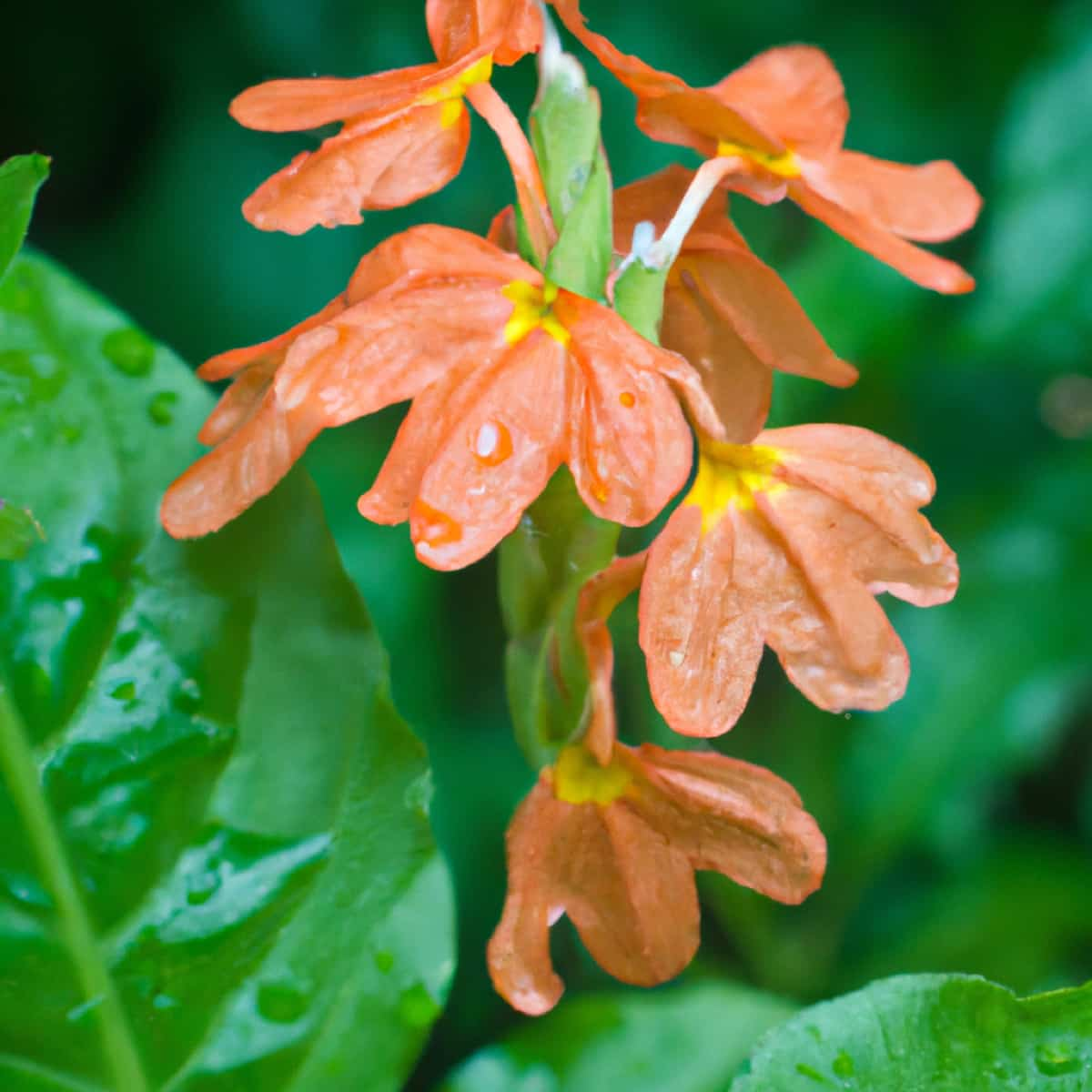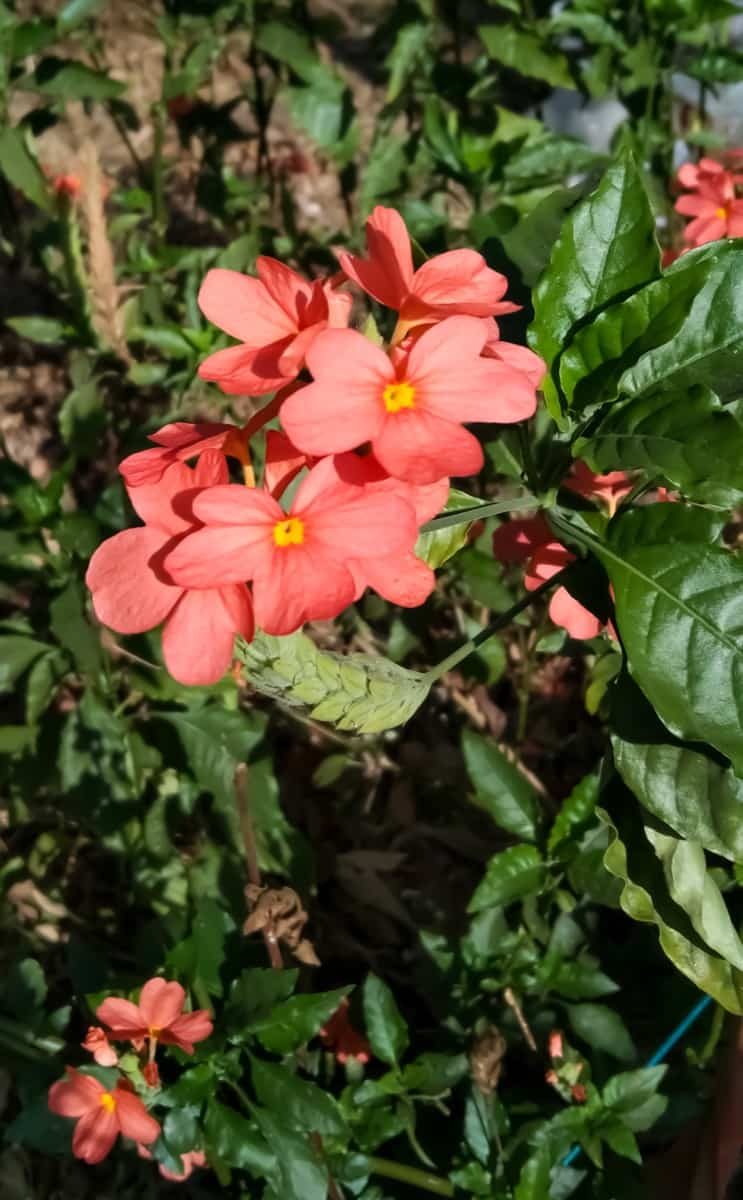Welcome to our blog on Common Crossandra plant pests and control! This article will explore the causal organisms, damage symptoms, spread, treatment options, prevention strategies, and management techniques for these pests. Take part with us as we investigate several methods for safeguarding your Crossandra plants while ensuring high-quality yields. Here we go. Let’s start.

Major and Common Damaging Crossandra Pests
Crossandra is a herbaceous flowering perennial in the Acanthaceae family, native to the tropical regions of India and Sri Lanka. These plants are known for their vibrant and eye-catching blooms. They are admired for their attractive foliage, which is often glossy and deep green. The flowers, borne in dense clusters, display various orange, yellow, and pink hues. Crossandra plants are valued for their ornamental appeal and are commonly cultivated in gardens and as indoor potted plants, adding a splash of color and beauty to any space.
| Pest | Characteristic Symptoms |
| Aphids | Honeydew, black sooty mold, ants, & chlorosis. |
| Thrips | Silvering or bronzing, dark fecal specks, & leaf and flower scarring. |
| Red Spider Mites | Yellow or brown specks, stippling, webbing, & premature leaf drop. |
| Mealybugs | White, cottony, wax, yellowing, honeydew, & black sooty mold. |
| Scale Insects | Small bumps, honeydew, black sooty mold, dieback, & plant decline. |
| Leaf Miners | Serpentine mines & swollen or raised blister patches. |
| Caterpillars | Skeletonized foliage, chewed leaf edges, & ragged leaf edges. |
| Slugs & Snails | Slime trails, irregular holes, & ragged leaf edges. |
| Root-knot Nematodes | Root galls or swellings, yellowing, & overall poor vigor. |
| Whitefly | Yellowing and wilting of leaves, honeydew, sooty mold, & decline. |
How to Identify and Treat Crossandra Pests
Aphids Pest Control in Crossandra
- Causal Organism: Aphis spp.
- Symptoms: The characteristic symptom is small, soft-bodied insects that suck sap from plant tissues. Infested plants show leaf curling, distortion, yellowing, stunted growth, sticky honeydew, black sooty mold, and ants.
- Favorable Conditions: They prefer warm and dry conditions of 15-27 °C, succulent plant growth, overcrowding, high nitrogen levels, and the absence of natural predators for feeding, reproduction, and survival.
- Treatment: Spray insecticidal soaps, neem oil, dimethoate, imidacloprid, and acetamiprid. Remove and destroy heavily infested plant parts. Use jet spray and natural predators like ladybugs and lacewings.
Thrips Pest Control in Crossandra
- Causal Organism: Thrips spp.
- Symptoms: The visible symptom is the presence of tiny, slender insects that feed by scraping plant tissues and sucking up the sap. Infested plants show leaf curling, silvering or bronzing, distorted growth, dark fecal specks, and leaf and flower scarring.
- Favorable Conditions: They prefer warm, arid, and dry conditions of 21-32 °C, overcrowded plantings, high nitrogen levels, and lack of natural predators for reproduction, and are more active during periods of low humidity.
- Treatment: Spray insecticidal soaps, neem oil, spinosad, pyrethroids, acetamiprid, or imidacloprid. Remove heavily-infested flowers or leaves. Release natural predators like predatory mites or minute pirate bugs.
Red Spider Mite Pest Control in Crossandra
- Causal Organism: Tetranychus spp.
- Symptoms: Spider mites are extremely small pests that feed on plant sap, causing tiny yellow or brown specks on the leaves. Infested plants show leaf yellowing, stippling, webbing, and premature leaf drop.
- Favorable Conditions: They prefer hot and dry conditions of 21-32 °C and < 60% humidity, dusty conditions, drought stress, over-fertilization, high-density plantations, poor air circulation, and infested plant debris.
- Treatment: Spray abamectin, fenazaquin, etoxazole, and spiromesifen. Remove heavily infested leaves. Regularly spray water to increase humidity and avoid drought stress. Use predatory mites.
In case you missed it: Rose Flower Chaffer Beetle Pest Management: Symptoms, Treatment, Chemical, Biological, and Organic Control

Mealybug Pest Control in Crossandra
- Causal Organism: Pseudococcus spp.
- Symptoms: The characteristic symptom is the white, fluffy masses on stems, leaf axils, and undersides of leaves. They are soft-bodied, oval-shaped insects covered in white, cottony wax. Infested plants show leaf yellowing, distortion, stunted growth, honeydew, and black sooty mold.
- Favorable Conditions: They prefer warm and humid environments of 21-27 °C and > 80% humidity, crowded plantings, sheltered areas, overwatering, excessive nitrogen levels, and poor air circulation.
- Treatment: insecticidal soaps, neem oil, thiamethoxam, imidacloprid, or acetamiprid. Remove the pests manually using a cotton plug dipped in alcohol or soapy water. Prune heavily infested plant parts. Use ladybugs or lacewings.
Scale Insect Pest Control in Crossandra
- Causal Organism: Coccus spp.
- Symptoms: The characteristic symptom is the presence of small, immobile pests, often appearing as small bumps on stems and leaves that feed on plant sap. Infested plants show leaf yellowing, wilting, stunted growth, drooping, honeydew, black sooty mold, dieback, and plant decline.
- Favorable Conditions: They prefer warm and dry conditions of 21-27 °C and < 50% humidity, stressed plants, inadequate light, poor nutrition, drought conditions, overcrowding, excessive nitrogen levels, and lack of natural predators for reproduction and survival.
- Treatment and Management: Spray insecticidal soaps, neem oil, imidacloprid, dinotefuran, or acetamiprid. Prune heavily infested plant parts, and use cotton dipped in alcohol and ladybugs or parasitic wasps.
Crossandra Leaf Miner Pest Control in Crossandra
- Causal Organism: Liriomyza spp.
- Symptoms: The characteristic symptom is the presence of pale white or yellowish translucent trails of serpentine mines on leaves. Infested leaves show swollen or raised blister patches, withered or discolored leaves, and reduced photosynthetic capacity.
- Favorable Conditions: They prefer moderate temperatures and high humidity of 21-27 °C and > 70% humidity, tender leaves, and lack of natural predators for egg-laying and larval development.
- Treatment and Management: Spray imidacloprid, abamectin, spinosad, pyrethroids, or thiamethoxam. Practice pruning and sanitation. Use reflective mulches and trap crops like nasturtium or marigold. Release parasitic wasps or predatory beetles.
Crossandra Caterpillar Pest Control in Crossandra
- Causal Organism: Spodoptera litura
- Symptoms: The visible signs of infestation are the presence of caterpillars and their droppings, resulting in irregular holes, chewed leaf edges, and skeletonized foliage. Infested plants show ragged leaf edges and extensive defoliation.
- Favorable Conditions: They prefer moderate temperatures of 17-25 °C, abundant foliage for feeding, suitable host plants, overcrowding, and lack of natural predators.
- Treatment and Management: Spray Bacillus thuringiensis, acetamiprid, imidacloprid, carbaryl, or spinosad. Handpick and remove caterpillars manually. Use physical barriers like row covers to prevent adult egg-laying. Inspect plants regularly for eggs or young larvae.
Slugs and Snails Pest Control in Crossandra
- Causal Organism: Deroceras spp.
- Symptoms: The visible signs are the presence of irregular holes and slime trails on the leaves, stems, flowers, and surrounding soil. Infested plants show ragged edges on leaves and shredding of leaves.
- Favorable Conditions: They prefer cool and moist environments of 10-21 °C and > 80% humidity, overwatering, dense vegetation, organic matter, and lack of natural predators for reproduction.
- Treatment and Management: Use baits containing iron phosphate or metaldehyde. Handpick and remove them manually. Practice sanitation to eliminate hiding spots. Use barriers like copper tape or diatomaceous earth around vulnerable plants.
In case you missed it: How to Identify and Treat Croton Pests: Symptoms, Prevention, and Control

Root-knot Nematode Pest Control in Crossandra
- Causal Organism: Meloidogyne spp.
- Symptoms: The characteristic symptom is the presence of galls or swellings formed by microscopic roundworms that live in the soil and feed on roots. Infested plants show stunted growth, yellowing, wilting, and overall poor vigor.
- Favorable Conditions: They prefer warm temperatures of 25-35 °C and moist soils with poor drainage, overwatering, and compacted soils.
- Treatment and Management: Apply methyl bromide, metam sodium, oxamyl, or fosthiazate. Solarize soil by covering it with clear plastic to kill nematodes. Remove infected plants.
Crossandra Whitefly Pest Control in Crossandra
- Causal Organism: Bemisia tabaci
- Symptoms: The characteristic symptom is the presence of tiny, white insects that feed on the undersides of leaves. Infested plants show yellowing and wilting of leaves, stunted growth, honeydew secretion, sooty mold, and plant decline.
- Favorable Conditions: They prefer warm and humid environments of 25-32 °C and >70% humidity, succulent plant growth, young leaves, new shoots, overcrowding, poor air circulation, and high nitrogen levels for development and reproduction.
- Treatment and Management: Spray insecticidal soaps, neem oil, imidacloprid, or acetamiprid. Remove heavily infested leaves. Use yellow sticky traps to control adult whiteflies. Release Encarsia wasps or predatory beetles.
Conclusion
Some major pests affecting crossandra plants include aphids, thrips, red spider mites, mealybugs, scale insects, leaf miners, caterpillars, slugs & snails, nematodes, and whitefly pests. Various organisms cause these pests and exhibit specific symptoms, modes of spread, and management approaches.
- Beneficial Insects in Pest Management
- Natural Solutions for Pest Control in Flower Gardens
- Types of Fungicides Used in Agriculture
- Common Issues in the Fruit Development Stage of Pomegranate Farming
- Fruit Development Issues in Papaya: Easy Solutions and Treatment
- Soil-Borne Diseases and How to Protect Your Plants
- Practices to Prevent Disease Spread in the Garden
- From Wilted to Thriving: How to Treat Root Rot Naturally in Houseplants
- Natural Remedies to Cure Brown Spots on Fig Tree Leaves